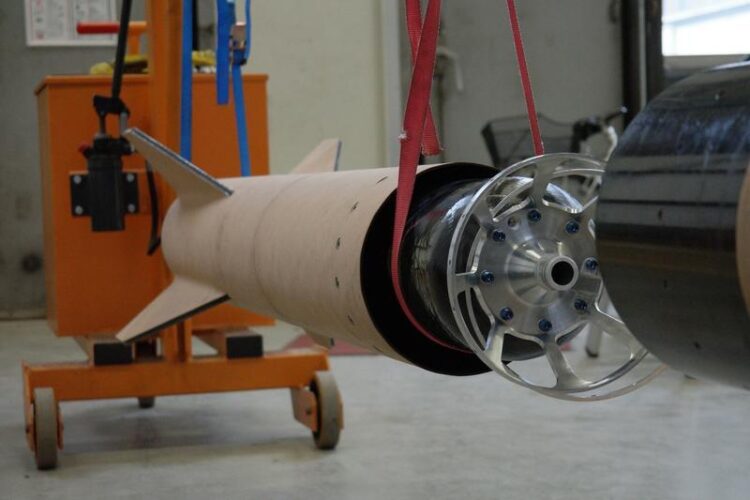World altitude record attempt

The first test of the assembly of the rocket components.
Credit: HyEnD / University of Stuttgart
Students of the University of Stuttgart launch self-built rocket into space.
The Hybrid Engine Development (HyEnD) student team at the University of Stuttgart spent around three years developing, manufacturing, and testing its hybrid rocket. In mid-April, the rocket will be launched into space from the Esrange rocket launch site near Kiruna in Sweden. If all goes well, the students will set a new world altitude record for student-built rockets.
The hybrid rocket is 7.80 m long and weighs around 70 kg. It was built by around 60 students from the University Group HyEnD of the University of Stuttgart. “It’s one of the most powerful and advanced student-built hybrid rockets in the world,” says Max Öchsle, HyEnD project manager. With this, the students have big plans: They want to beat their own altitude record of 32 km for student-built hybrid rockets, which they set in 2016.
The students also hope to cross the boundary into space at an altitude of 100 km. In addition to the world record for hybrid rockets, this also makes the world record for student-built rockets in general possible. The previous record is 103.6 km and was set by the University of Southern California (USCRPL) team in 2019. “The world record is within our reach. We could indeed beat it,” says Öchsle. Öchsle is well aware that the record depends on other factors such as the weather.
It is still unclear exactly when the record attempt will take place. The window is scheduled between April 14 and 25. Because the schedule could be changed at short notice, HyEnD provides regular updates on its website: https://hyend.de/index.php/category/n2orth-launch-campaign/ In addition, a livestream of the launch is planned on the Youtube channel of the Swedish Space Agency SSC: https://www.youtube.com/@SwedishSpace. On site in Sweden are 16 members of the student group, including Öchsle, the 25-year-old project leader: “The launch of the rocket will be a special moment for me.” Over the past three years, a lot of blood, sweat, and tears have gone into this project. The countdown to the launch will certainly be exciting. But we are confident that everything will go according to plan. Of course, I’m most looking forward to the moment when the rocket takes off.”
In order to be on the safe side, the students have two identical rockets on site. On one hand so they have a back-up in case something breaks during launch preparations. On the other hand, because the rocket project is quite ambitious for a group of students. For the first flight of an untested rocket, there are restrictions on the launch angle and thus on the flight altitude. If the first flight goes well, students hope to fly higher on the second launch.
Hybrid engine delivers 1.5 t of thrust
The N2ORTH rocket has a hybrid engine that uses solid fuel and liquid nitrous oxide. The name N2ORTH alludes to both nitrous oxide (N2O), which is used as an oxidizer, and the launch site in the North. In order to make it as light as possible, it was built almost entirely of composite materials.
“We are particularly proud of the engine which we developed ourselves. With its thrust of up to 1.5 t, it is one of the most powerful and efficient student made engines in the world. Another special feature is the parachute, which must be able to withstand supersonic speeds. Because there are no commercial parachutes available for these requirements, we made it ourselves,” says Öchsle. Because of the high flight speeds, the rocket shell is exposed to enormous temperatures. The structural parts were therefore laminated with a high-temperature epoxy system developed in house. The rocket also has a thermal protection layer made of cork. The students manufactured most of the components themselves in the workshops of the University of Stuttgart.
The development of the rocket was made possible by the STERN student experimental rocket program funded by the German Aerospace Center (DLR). The project began in the fall of 2019, and the launch in Sweden will mark the completion. The project is located at the Institute of Space Systems (IRS) at the University of Stuttgart. The Materials Testing Institute provided workshops and rooms. In addition, numerous other institutes have supported the students in their endeavors.
Wissenschaftliche Ansprechpartner:
Julian Dobusch, Press and Public Relations HyEnD, University of Stuttgart, E-mail: info@hyend.de
Weitere Informationen:
English-language website with current schedule and regular blog articles: https://hyend.de/index.php/category/n2orth-launch-campaign/
On their Instagram account @hyend_uni-stuttgart, the students provide daily information during their stay in Sweden.
Media Contact
All latest news from the category: Physics and Astronomy
This area deals with the fundamental laws and building blocks of nature and how they interact, the properties and the behavior of matter, and research into space and time and their structures.
innovations-report provides in-depth reports and articles on subjects such as astrophysics, laser technologies, nuclear, quantum, particle and solid-state physics, nanotechnologies, planetary research and findings (Mars, Venus) and developments related to the Hubble Telescope.
Newest articles

Innovative 3D printed scaffolds offer new hope for bone healing
Researchers at the Institute for Bioengineering of Catalonia have developed novel 3D printed PLA-CaP scaffolds that promote blood vessel formation, ensuring better healing and regeneration of bone tissue. Bone is…

The surprising role of gut infection in Alzheimer’s disease
ASU- and Banner Alzheimer’s Institute-led study implicates link between a common virus and the disease, which travels from the gut to the brain and may be a target for antiviral…

Molecular gardening: New enzymes discovered for protein modification pruning
How deubiquitinases USP53 and USP54 cleave long polyubiquitin chains and how the former is linked to liver disease in children. Deubiquitinases (DUBs) are enzymes used by cells to trim protein…


